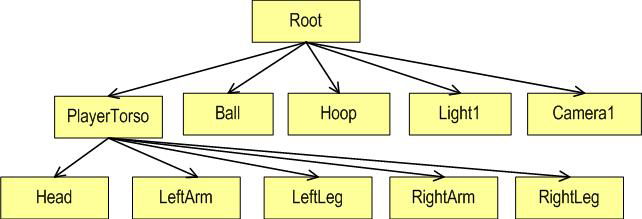Show in Contents

Add to Favorites

Home: Autodesk FBX SDK Progammer's Guide

Traversing the Scene Graph

Traversing the Scene Graph

Creating a scene and getting its root node

Introducing the FBX scene
In FBX, a scene is
a container for all the meshes, NURBS, cameras, lights and other
scene elements that make up a 3D scene.
Each element in the scene
is called a node. The data structure used
to organize all the nodes in a 3D scene is commonly called the scene
graph. In FBX, the scene graph is specifically a tree:
- The root node of the scene graph has
no parent.
- Every other node in the scene graph has
exactly one parent.
- Every node can have zero, one, or many
children.
Here
is a diagram showing an extremely simple scene containing a camera,
a light, a ball, a hoop, and a stick figure of a basketball player:
Notes on FBX scenes:
- An FBX application must have a root node.
But the root node is never saved in an FBX file. Accordingly, do
not use the root node to represents anything “real” in the scene
that you may want to save in a file.
- The scene object points to the root node
of the scene. Each node, including the root node, points to its
children. Accordingly, with the scene object as a starting point,
you can traverse the entire tree.
- An FBX application can have more than
one scene. But an FBX file can store only one scene.
